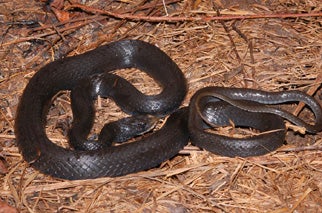SCIENTIFIC NAME:
Coluber constrictor
STATUS:
Common statewide, but declining in many areas. Includes subspecies C.c.constrictor (northern black racer) and C.c. priapus (southern black racer). Low Conservation Concern.
DESCRIPTION:
The black racer (Coluber constrictor) is a relatively long and slender snake. They are usually between three and five feet long, but some individuals may reach lengths of more than six feet. Black racers are, as the name implies, solid deep black in color on their upper side. Their bellies vary from dark gray to black, and some white frequently occurs on the chin and throat. Their eyes are brown, and their scales are smooth. Young snakes are tan or grayish in color with a series of brown or reddish blotches running down the center of the back. The color pattern present in juveniles fades to black as they grow older. Black racers are an alert and very active species. They are quick to flee when approached, but will fight aggressively when cornered.
DISTRIBUTION:
Black racers (Coluber constrictor) are found throughout the eastern United States from southern Maine to the Florida Keys. Two subspecies exist both of which occur in Alabama. The northern black racer (Coluber constrictor constrictor) is found in Alabama’s northeastern counties while the southern subspecies (Coluber constrictor priapus) occupies the remainder of the state. These subspecies look alike. They can be differentiated only based on internal anatomical characteristics.
HABITAT:
Black racers are generalists with regard to the habitats they inhabit. They can be found in virtually any of the southeast’s varied habitats, but are more abundant in edge type habitats where two or more habitats meet such as the borders of swamps, old fields, and agricultural lands.
FEEDING HABITS:
Black racers feed only during daylight hours, and will eat just about anything. Rodents, birds, lizards, other snakes, frogs, toads, and insects are all a part of their diet. When prey is captured, racers press down on their victim with a loop of their body to immobilize it, but they do not kill their prey by constriction as do many other snakes.
LIFE HISTORY AND ECOLOGY:
Black racers mate in the spring. Females lay up to 36 eggs in early summer. The eggs are coated with small nodules resembling grains of sand. The eggs will hatch in late summer or early fall. Hatchling racers are 7.5 to 14 inches in length.
REFERENCES:
Cognant, R., and J.T. Collins. 1998. Reptiles and Amphibians Eastern/Central North America. Houghton Mifflin Co., Boston, MA. 616 pp.
https://srelherp.uga.edu/snakes/black-racer/
AUTHOR:
Chas Moore, Wildlife Biologist, Alabama Division of Wildlife and Freshwater Fisheries






